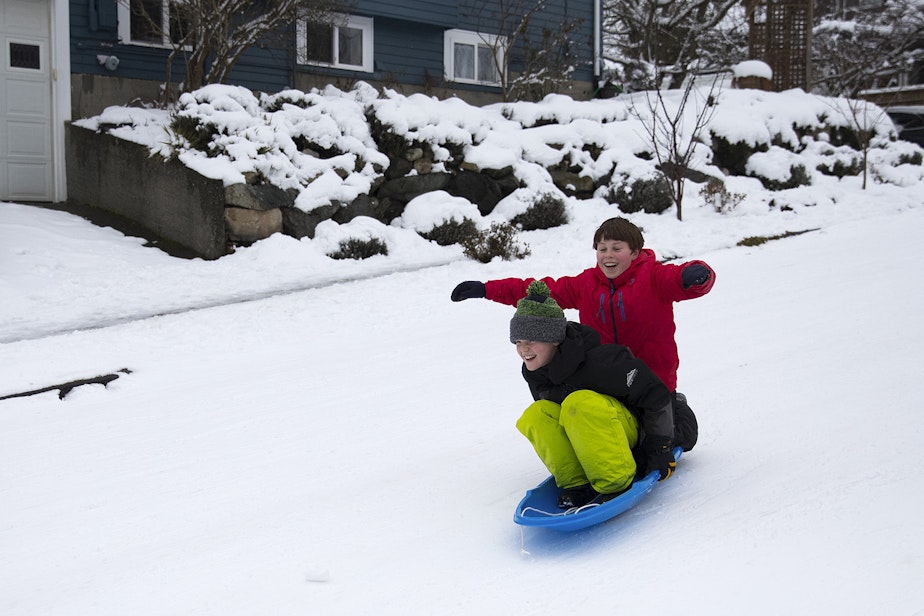What is the point of mid-winter break?

A week-long school vacation in February — just weeks after the holiday break — is unheard of in most parts of the country. But it's become standard for more affluent districts in Washington state in recent years. Kim Malcolm sat down with education reporter Ann Dornfeld to discuss the history of mid-winter break.
This peculiarity of the school calendar appears to go back more than a century in parts of New England, but is a recent development in the Seattle area.
Mid-winter break — known elsewhere as winter break, Presidents' Week, February vacation week or mid-winter recess — took hold in the Northeast during the energy crisis of the 1970s as a way to save on heating costs and bus fuel.
In Europe it's common to see a week off in January or February called "White Week" meant for ski holidays.
That’s also true in some posh suburbs of San Francisco, especially at private schools, where it's been called "ski week" going back generations.
How did we end up with mid-winter break in the Seattle area?
Sponsored
In an effort to figure this out, I visited the Seattle Public Schools archives, and spoke to four current and former presidents of Seattle’s teachers union.
They said that in districts with mid-winter break, teachers took fewer sick days — not because they weren’t getting the flu that week, but because it’s a tough time of year for many teachers.
There’s the run-up to standardized testing, which has often been high-stakes, and spring break is still months away.
Wendy Kimball, a former union president, told me that for teachers who get overwhelmed during the school year, that’s when they tend to "blow their stack" at their colleagues or at students.
Kimball said the union had to do more interventions with teachers around this time of year, making it a good time of year to let teachers take some time to unwind.
Sponsored
Seattle’s teachers’ union and the district agreed to a six-day mid-winter break starting in 1997. But there was a caveat: Some of the days could be used as snow make-up days.
Over the years it was a short break some years, a full week others, but it has settled into a regular week off.
Over the past 20 years, many districts in Washington have adopted mid-winter break. Today about half of the state’s 295 districts have a mid-winter break of some sort, although most of them are just a long weekend — often Friday through Presidents' Day.
Only 26 percent of all Washington districts have week-long breaks, according to the Office of Superintendent of Public Instruction — mostly in more prosperous areas.
Seven of the state’s eight wealthiest districts in terms of household income offer a week-long break – including Mercer Island, Bainbridge Island and Issaquah.
Sponsored
Similar to the San Francisco suburbs, this week in February is popular with well-off families for a winter getaway for skiing or sun.
It's one of the busiest weeks of the season at Whistler Blackcomb ski resort, thanks to all the Washington families vacationing, according to a spokesman there.
Still, mid-winter break is controversial.
Folks at the union said teachers have been divided about whether they want a week-long break.
Some feel that it’s too long to wait until spring break in April.
Sponsored
Others say mid-winter break disrupts the flow of the school year, and they'd rather that school get out a week earlier in June.
Parents come down on both sides of the issue, too.
For families who have the money, it’s a popular time to get away.
The problem is that it's an equity issue: Many Seattle families don’t have the money to hit the slopes or to jet off to Maui. They’re stuck in Seattle trying to figure out what to do with their kids. There aren't near the same child care or activity options in February as in summer, so families can find themselves in a bind.
This is highlighted this year, as mid-winter break comes right on the heels of five school snow days and many days of snow-related late arrivals or early dismissals that threw parents for a loop.
Sponsored
These same factors are having a chilling effect on mid-winter break in New England, where a growing number of districts are scaling back mid-winter break, or eliminating it altogether.





